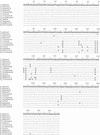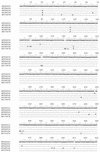Identification of dermatophyte species by 28S ribosomal DNA sequencing with a commercial kit
- PMID: 12574293
- PMCID: PMC149666
- DOI: 10.1128/JCM.41.2.826-830.2003
Identification of dermatophyte species by 28S ribosomal DNA sequencing with a commercial kit
Abstract
We have shown that dermatophyte species can be easily identified on the basis of a DNA sequence encoding a part of the large-subunit (LSU) rRNA (28S rRNA) by using the MicroSeq D2 LSU rRNA Fungal Sequencing Kit. Two taxa causing distinct dermatophytoses were clearly distinguished among isolates of the Trichophyton mentagrophytes species complex.
Figures


References
-
- Gräser, Y., M. El Fari, R. Vilgalys, A. F. A. Kuijpers, G. S. De Hoog, W. Presber, and H.-J. Tietz. 1999. Phylogeny and taxonomy of the family Arthrodermataceae (dermatophytes) using sequence analysis of the ribosomal ITS region. Med. Mycol. 37:105-114. - PubMed
-
- Gräser, Y., A. F. A. Kuijpers, W. Presber, and G. S. De Hoog. 1999. Molecular taxonomy of Trichophyton mentagrophytes and T. tonsurans. Med. Mycol. 37:315-330. - PubMed
-
- Gräser, Y., A. F. A. Kuijpers, M. El Fari, W. Presber, and G. S. De Hoog. 2000. Molecular and conventional taxonomy of the Microsporum canis complex. Med. Mycol. 38:143-153. - PubMed
Publication types
MeSH terms
Substances
Associated data
- Actions
- Actions
- Actions
- Actions
- Actions
- Actions
- Actions
- Actions
- Actions
- Actions
- Actions
- Actions
- Actions
- Actions
LinkOut - more resources
Full Text Sources
Other Literature Sources

